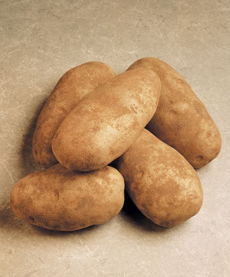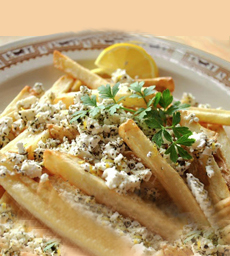TIP OF THE DAY: Your Own Signature French Fries
|
While the Belgians may or may not have invented what we call French fries (see the history below), they do consume the most French fries per capita of any country in Europe. And we would have thought that Americans took that prize!
Call them French fries or simply fries in America, chips in the U.K. or American fries in many parts of the non-European world: It’s hard to find anyone who doesn’t like julienned, fried potatoes and the other shapes that evolved from them: crinkle fries, curly fries, shoestring fries, steak fries, waffle fries, wedges, etc. And then, there are French fry toppings that create new dishes, from chili cheese fries to the beloved Canadian dish, poutine: brown gravy and cheese curds atop fries. |
Fries Greek-style, with crumbled feta and oregano. Photo courtesy Stix Mediterranean Grill | New York City. |
|
|
So your culinary challenge of the week is to come up with your own own signature topping for fries. Here are some categories to choose from and some examples in each: THE HISTORY OF FRENCH FRIES French fries are not French in origin, experts agree. Credit may go to the Belgians. But let’s start in the beginning. The potato is a New World food which grew wild in Peru. It was cultivated and spread to other parts of Latin America. In 1537, Gonzalo Jiménez de Quesada, a Spanish explorer and conquistador, was exploring a village in Colombia. He and his troops found the locals eating potatoes, which were small and bitter. Initially, the Spaniards called them “truffles” because they grew underground. Samples were brought back to Europe and bred into larger, less bitter versions. But they were used as animal feed: Along with tomatoes, they were thought to be poisonous to humans. We don’t know exactly when the first human ate a batch of sliced, fried potatoes. Historical accounts indicate that the Belgians might have been frying up thin strips of spuds in the late 17th century, as a substitute for fried fish when the rivers were iced over. |
||
 Burbank, Idaho and russet potatoes are best for fries. Photo courtesy Idaho Potato Commission. |
What was happening in France? Like other Europeans, the French were growing potatoes for hog feed. In fact, convinced that potatoes caused leprosy, the French Parliament banned cultivation of potatoes in 1748. Potatoes as human food had one champion, a French army medical officer named Antoine-Augustine Parmentier. While a prisoner of war, he was forced to eat potatoes and found the “poison” theory simply wasn’t true. In 1772, the Paris Faculty of Medicine finally proclaimed that potatoes were edible for humans, though it took a famine in 1785 for the French to start eating them in earnest. In 1802, Thomas Jefferson’s White House chef, Honoré Julien, a Frenchman, served “potatoes served in the French manner” at a state dinner. The potatoes were “deep-fried while raw, in small cuttings.” This is one of the earliest references to “French” fries. You can read the details here. |
|
|
FRENCH FRY TRIVIA You need a floury/starchy potato variety, which is lower in moisture (drier). Examples include Idaho, russet and russet Burbank. Check out the different types of potatoes.
|
||



